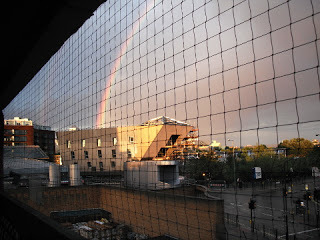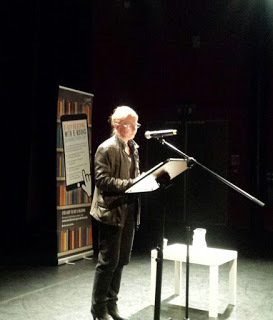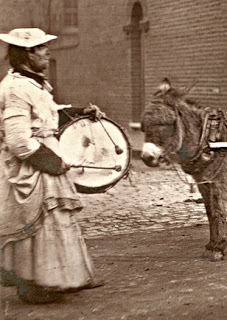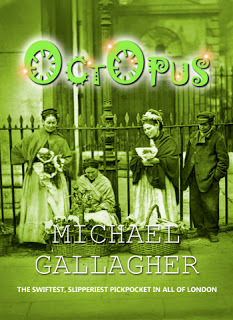Michael Gallagher's Blog, page 6
September 1, 2016
September 2016: After 25 years as a teacher I retire to write full time
 It is official. On September 22nd, I shall be retiring from Bede, where I have taught adults with learning disabilities for the past twenty-five years. Bede is a local community charity that believes that strong, confident communities enable people to flourish. The Learning Disabilities Services is just one branch of the various work we engage in. The photo to your left is a small part of a much bigger picture (quite literally; visit my website to see the whole thing). For a number of years now its creator, Kevin Ireland, has produced image after memorable image for us, but this one has to be my favourite. It was the cover of our 2014/15 annual report, and I think it sums up Bede in a nutshell. I can put a name to barely half these people—but that’s all right; we all have one thing in common. We are all part of this amazing community.
It is official. On September 22nd, I shall be retiring from Bede, where I have taught adults with learning disabilities for the past twenty-five years. Bede is a local community charity that believes that strong, confident communities enable people to flourish. The Learning Disabilities Services is just one branch of the various work we engage in. The photo to your left is a small part of a much bigger picture (quite literally; visit my website to see the whole thing). For a number of years now its creator, Kevin Ireland, has produced image after memorable image for us, but this one has to be my favourite. It was the cover of our 2014/15 annual report, and I think it sums up Bede in a nutshell. I can put a name to barely half these people—but that’s all right; we all have one thing in common. We are all part of this amazing community.Bede was founded in 1938, in the London Borough of Southwark, roughly a mile or so to the east of Tower Bridge. It has historical links with Clare College, Cambridge, and we benefit not only from the occasional recital by their world-famous choir, there is a programme whereby each year a graduate will come to work for us, be it in our Learning Disabilities Services, our Domestic Violence and Hate Crime Project, or our Youth Adventure Project; it’s their choice.
When I first joined Bede I was warned that funding for the Voluntary Sector was notoriously hard to come by, and that I might expect the post to last maybe two or three years at most. Twenty-five years on, the prediction has finally come true. In the past two or three years the Voluntary Sector has faced swingeing cuts in funding whilst it is increasingly relied upon to deliver the statutory services that Councils can no longer provide. Employers are faced with impossible choices and one terrible certainty: they cannot run on a deficit forever.
Severing the “our” when I talk about Bede is going to be difficult for me. I was there when the Learning Disabilities Services was naught but a very modest Cafe Training Project working with a mere three people a day. I was there when the far-right National Front decided to target us on a regular basis. I was there when Bede was awarded the Queen’s Award for Voluntary Service, the MBE for volunteer groups. When I leave, I intend to join as a Friend of Bede, so maybe the “our” can remain. How do I intend to fill my days? Well, the plan is to write full time, which shouldn’t prove too problematic. I already do.
In other news, this month I’m enormously pleased with myself because I’ve finally joined Twitter. I found the process frustrating, though, because time and again the photos for the page refused to load, I couldn’t have one of the @names I wanted (believe it or not, @seventhrainbow was already taken), and the site kept defaulting to its mobile state where it wouldn’t let me add or change a thing. But I persevered! Oh, yes! I persevered. So now I’m the proud owner of an author account, Michael Gallagher @seventh7rainbow. Gooseberry, you may be interested to know, has his own separate account, @sendforOctavius, which I love to bits. He hasn’t tweeted yet, and still he has more followers than I do! Hmmm. No, I jest. Hurrah!!!
Happy reading!
Michael
Find me on Facebook, @seventh7rainbow, or at my website michaelgallagherwrites.com.
Follow Octavius Guy @sendforOctavius
Photo (detail) used with the kind permission of Kevin Ireland
Published on September 01, 2016 06:27
August 1, 2016
August 2016: Do you fancy novels of the Crimes & Thrillers variety?
 It’s August, a month that’s meant to be the height of summer for us here in the UK. Two weeks ago we got a couple of days of very belated spring, then summer arrived with a sudden blast of ferocious heat. Who knows what we have in store, but I will say this: the coots on Canada Water, who are great predictors of late summers, have begun their second cycle of nesting for the year.
It’s August, a month that’s meant to be the height of summer for us here in the UK. Two weeks ago we got a couple of days of very belated spring, then summer arrived with a sudden blast of ferocious heat. Who knows what we have in store, but I will say this: the coots on Canada Water, who are great predictors of late summers, have begun their second cycle of nesting for the year.Last month I talked about two of my favourite libraries, including the my local one, the Canada Water Library. I’ve been attending the Crimes & Thrillers reading group there for about five years now. Unfortunately, because it is such a small group, the library management no longer felt it could justify assigning a member of staff to run it. The core members of the group were so unwilling to let it go, we’ve decided to run it ourselves and to take it online. So, say FAREWELL to the Canada Water Library Reading Group, and a big HELLO to the Canada Water Crime & Thrillers Book Club on Facebook!
We may be small, but we’re a friendly and enthusiastic bunch who read widely—from classics by the likes of Wilkie Collins (we’ve read both The Moonstone and The Woman in White) to recent novels such as The Girl on the Train—but most of us have a soft spot for the “cosy” type of mystery. Most recently we’ve read Susan Hill’s The Man in the Picture (she wrote The Woman in Black), Murder of a Lady by Anthony Wynne (one of the British Library’s Crime Classics), and Andrea Camilleri’s Game of Mirrors. Coming up we hope to have J. K. Rowling writing as Robert Galbraith with The Cuckoo’s Calling, then a volume of James Runcie stories, Sidney Chambers and the Problem of Evil, an early Amelia Peabody, The Curse of the Pharaohs, Lindsey Davis’s swords-and-sandals detective Falco in Venus in Copper, and we’ll round the year off with C. J. Sansom’s Tudor-set Dissolution. There’s always a chance that the books we’ve ordered will not be available—but if you join the group (click on the link above) we will keep you updated.
Unless advertised otherwise, we meet at 2 pm at Canada Water Library on the fourth Thursday of every month. If you live locally and fancy the title we’re currently reading, why not come along and join us to share your thoughts about the book? You’ll find copies available to borrow at the reception desk on the ground floor roughly four weeks prior to the meeting.
If you live elsewhere in this big, wide world of ours, you are most welcome to join us online. Perhaps you’ve read one of our forthcoming books? If you join us, you can share your thoughts by posting your comments under the appropriate post. We’ll try to read through them at the meeting (sadly, the wifi can be a bit dodgy). Either way—whether in person or online—we look forward to hearing from you soon!
The photo of Canada Water Library by Malane Whillock is used with kind permission.
Happy reading!
Michael
Find me on Facebook or at my website michaelgallagherwrites.com.
Published on August 01, 2016 06:27
July 1, 2016
A look at two wonderful libraries
 It’s July, and I’m thrilled and relieved to announce that Malane, who designs and maintains my website for me, is back at the helm after a few months break. She and I recently attended Canada Water Library to hear author Lionel Shriver talk about her new novel, The Mandibles. And a very good talk it was, too, with Lionel reading out passages and interspersing them with explanations and observations bursting with her gentle, acerbic wit.
It’s July, and I’m thrilled and relieved to announce that Malane, who designs and maintains my website for me, is back at the helm after a few months break. She and I recently attended Canada Water Library to hear author Lionel Shriver talk about her new novel, The Mandibles. And a very good talk it was, too, with Lionel reading out passages and interspersing them with explanations and observations bursting with her gentle, acerbic wit.Had we wished to see her speak at the Adlburgh Literary Festival—held at the wonderfully-named Snape Maltings—tickets would have set us back £11 each, but this event—as with most literary events held at Southwark’s various libraries—was free. Yes, FREE! And it came hot on the heels of a talk by another author, Dorothy Koomson, which was equally as enjoyable. As regular attendees at the Canada Water events, we have in fact seen both authors speak there before.
With access to world-class writers virtually on our doorstep (we’ve also seen Deborah Moggarch and Stella Duffy, to name but a few) it’s easy to forget that over the past few years, in response to governmental budget cuts and restrictions, the rest of London’s boroughs are closing library branches, or cutting opening hours, or handing their running over to volunteers. Most recently I heard of one being turned into a gym. Yet during this time Southwark Council has opened two new libraries, one at Canada Water Library in 2011, the other at Camberwell in 2015. As a small indication of Canada Water’s success, it currently ranks as the second busiest public library in London, and the sixteenth busiest nationally.
So what makes Southwark Council so different from all the other boroughs’ councils? I think they understand how important local libraries are to local communities, and when they design them, they design them to be community hubs, not just places where people come to check out books. At Canada Water, you can get a coffee and a snack, read newspapers, learn how to use the internet, go online, borrow the latest films, attend a reading group. There’s always a class from a local primary school having a story read to them. But none of this would happen without two important things: the council’s resolute vision and a dedicated and talented staff.
While I’m on the subject of libraries, there is another library I’m beginning to fall in love with: the British Library. At the end of last year I was shocked to discover that they’d gone into the business of publishing, and over the past few months the Canada Water Crime & Thrillers Book Club I attend has been devouring some of the rare and out-of-print titles they’ve resurrected as British Library Crime Classics from the Golden Age of Crime Writing. Trust me, the covers alone are worth a look.
Then I discovered that, in an act of supreme generosity, the British Library had digitised and uploaded over a million images to Flickr from old publications where the copyright has now expired. Anyone can use them free, gratis. Click here to find links to the various categories on offer.
The third thing I discovered, though, has to be the wackiest of the lot. For many decades the British Library has been a repository for sound recordings of everyday British life. Until recently you had to travel to the library to consult these recordings, but now they are available online. The one I came across just happens to be about food, and how people who have worked in the food industry have seen changes to the way our food is made, sold, and eaten. Listen to Radio 4’s Food Programme, where presenter Sheila Dillon discusses these archives with British Library archivists Polly Russell and Barley Blyton, or visit the National Life Stories Food Collection to explore it for yourself.
While you’re at it, make sure you check out the British Library’s Facebook and Twitter feeds. I was so impressed when I saw them. It’s like exploring a new world every day!
Visit my website to see photos of Canada Water Library, and to discover one of my favourite British Library uploads to Flickr. The photo of Lionel Shriver (above) is used with the kind permission of Southwark Libraries.
Happy reading!
Michael
Find me on Facebook
Published on July 01, 2016 06:31
June 1, 2016
What's next for Gooseberry?
 Octavius Guy and the Case of the Mendacious Medium (AKA “Big Bona Ogles, Boy!”—pronounced “bone-ah” “owe-gulls”, translation: Pretty Big Eyes You’ve Got There—a title that Malane, who designs my website for me, hates) is progressing a treat. I’ve finished a very rough draft of what I like to think of as “The First Act”, and am taking a few weeks’ break in order to plot the remainder. I have a victim, a motive, and a murderer; but more importantly I have a feel for the book—I know what the novel’s about. So what can I reveal without giving too much away?
Octavius Guy and the Case of the Mendacious Medium (AKA “Big Bona Ogles, Boy!”—pronounced “bone-ah” “owe-gulls”, translation: Pretty Big Eyes You’ve Got There—a title that Malane, who designs my website for me, hates) is progressing a treat. I’ve finished a very rough draft of what I like to think of as “The First Act”, and am taking a few weeks’ break in order to plot the remainder. I have a victim, a motive, and a murderer; but more importantly I have a feel for the book—I know what the novel’s about. So what can I reveal without giving too much away?Well, this time Gooseberry doesn’t go it alone. He’ll have his new, unofficial apprentice George to keep him company. It’s a snowy December in 1852, and together the pair attend a séance hosted by a certain Mrs Maria Harmon, a young Spiritualist trance medium recently arrived from Boston, Massachusetts—and what a séance it proves to be! Mrs Harmon manges to conjure up the spirit of an especially ill-behaved little girl, much to the horror of everyone present.
As with the preceding novels in this series, this one is also founded in fact. Towards the end of 1852, the young medium Mrs Maria B. Hayden and her husband William travelled to Britain from their home in Hartford, Connecticut, to bring Spiritualism to these shores for the very first time. She held regular séances in London, but they were met with a fairly mixed response. The literary world, in particular, was nothing less than scathing of her. George Henry Lewes, who was later to become the partner of the writer George Eliot (author of Middlemarch, Silas Marner, The Mill on the Floss, etc., etc.), played an especially mean trick on the woman. Unseen by Maria, he wrote out a question on a sheet of paper: “Is Mrs Hayden an impostor?” The spirit controlling Maria rapped out: “Yes”, causing Lewes to claim this as an admission of her guilt.
In reality, Maria Hayden’s mediumship was limited to producing raps and fielding questions, the answers to which were known only to those who asked them. The Mendacious Medium in Big Bona Ogles, Boy! goes much, MUCH further than that, with tricks in her repertory that historically date from some twenty years later. Does Gooseberry manage to work out how she does it? Yes…but he needs a little inadvertent help from George to show the way!
This month I start my long summer break from teaching, which means I’ll be able to throw myself wholeheartedly into the writing. I’m hoping to have Octavius Guy and the Case of the Mendacious Medium ready for general release on December 1st. It’s a tall order, but I think it’s achievable. In the meantime, you can Find me on Facebook
Published on June 01, 2016 06:54
May 1, 2016
For the love of Bertha
 A good number of reviews for Octopus have come in from LibraryThing Early Reviewers who are new to my work, and I am truly gratified and not just a little relieved to see that they seem to have taken young Gooseberry to their hearts. To quote just some of my favourites:
A good number of reviews for Octopus have come in from LibraryThing Early Reviewers who are new to my work, and I am truly gratified and not just a little relieved to see that they seem to have taken young Gooseberry to their hearts. To quote just some of my favourites:“For those who hanker for a whodunit played out in the streets of Victorian England, this is a must read. Follow the footsteps of protagonist Octavius through the narrow lanes that harbour cut throats, confidence men, thieves and just plain odd characters that sport Dickensian names.”
“I love Victorian mysteries in general and Sherlock Holmes in particular…Gooseberry could perfectly be the leader of the “irregulars” of Baker Street.”
“Historical fact is deftly combined with fiction that makes Octavius’s world a new form of old London that I am eager to visit again. Pour some tea or a wee dram, put your feet up, and enjoy cover to cover.”
You’ll find these reviews in full on my website, plus many, many more besides. While people have clearly fallen under Gooseberry’s spell, you may be not be surprised to learn that Bertha regularly merits a mention too. Here’s what some of my new readers have said of her:
“I particularly enjoyed the cross dressing flower seller, Bertha, who is treated as just another character and not made to be a caricature.”
“I especially appreciated the inclusion of Bertha and the narrator’s complete acceptance of his/her gender identity. You don’t often find books set in contemporary times where that is the case so it was especially refreshing to see such acceptance and support in Victorian London.”
But perhaps my personal favourite is this: “I LOVED Bertha/Bertram. I wanted to be her friend.”
And what a great friend I think she’d make! Bertha is generous, resourceful, and quite the dab hand at soup-making. She can be surprisingly prudish or really quite salty in equal measure, and you can never be sure which one will come out. She has highly developed mothering instincts and will fight tooth and claw for those she sees as family. Money is important to her—money is important to everybody, but more so to her, for she has known times of real hardship—so I was pleased to have been able to give her both prestige and financial security by the end of book 2 (though—and this is not really a spoiler—the start of book 3 finds her temporarily strapped for cash). She was even nominated for Villain of the Year in a book-award competition on Facebook by a reader with a very wry sense of humour (hint: she was not the book’s villain). And she made it through to the final round of voting! But where did she spring from exactly? How did I come to create her? Here is the very first mention of her in Gooseberry , the forerunner to Octopus :
‘Of course, I could be wrong,’ Mrs Merridew admitted, ‘but I honestly don’t think that I am. You see, although I couldn’t say why exactly, I was truly fascinated by the creature. There was something utterly compelling about her that I couldn’t quite put my finger on.’
A picture was already beginning to form in my mind. ‘What colour was her hair?’ I asked. ‘And how was she dressed?’
‘Coarse, dark brown shoulder-length hair, parted in the middle and pulled back into a bun,’ the aunt reeled the description off excitedly, her distrust of me temporarily forgotten. ‘Yellow cap and ribbons instead of the usual headscarf affair. A light-grey blouse, which hung from her shoulders like a sack, and a tattered, dark-grey skirt. A filthy red shawl, one end of which she held across her mouth, I imagine to try to hide her scars.’
‘I remember the shawl,’ Mrs Blake agreed, her nose wrinkling up at the thought. ‘I wouldn’t put it anywhere near my lips.’
‘Broad-shouldered? Arms like hams?’
‘Why, yes, Gooseberry; that’s right.’
‘And softly spoken?’
‘So softly spoken I could hardly make out anything she said,’ Mrs Blake replied. ‘Aunt Merridew had to ask the price of the posy several times.’
The old lady nodded in agreement.
‘She kept her eyes averted? Never once looked at you directly?’
‘Gooseberry? Do you know her?’
And it turns out that Gooseberry does. It is, of course, Bertha, whom he knows to be a man. Bertha is one of the most endearing and beloved characters I’ve ever had the pleasure to write—and believe me, writing her is a pleasure. I sit slumped at the keyboard with my eyes narrowed, adopting a faintly puzzled, mistrustful expression; my voice drops by about an octave and takes on the Cockney accent of one of my friends...and out flows Bertha. I can barely type fast enough to keep up. Although it seems unthinkable to me now, I originally planned on having someone very different fill the role, a role that I imagined would be a very minor one: villain Johnny Knight’s girlfriend, who still pops up, but now as the girl selling pencils in the Thames Tunnel.
It would have happened, too, were I not in the habit of having a glass or two of wine in the evenings while I reflected on the day’s work. I had just finished writing the opening chapter of Gooseberry (which was written and published week by week on the fly without the benefit of a predetermined plot), and suddenly the thought came to me, why not make her a man? Another glass, and the idea seemed slightly less ridiculous. Though it still felt like a risk, the whole venture was risky. On the upside, it gave me a character of my own to develop and nurture (many of the characters, including Gooseberry, were taken from Wilkie Collins’s The Moonstone), someone with a bit of heft who could come to the aid of the boy detective when necessary. And so Bertha was born.
Writers often create back-stories for their characters, a lot of which may never make it on to the page, but is useful for determining how they will react in certain situations. So what can I tell you about Bertha that you don’t yet know? She’s somewhere in the vicinity of forty years old; she was born to elderly parents; she and her mother suffered abuse at the hand of her father; her father disappeared in mysterious circumstances the year Bertha turned fifteen; I think her mother is still alive; her father is most definitely not.
Is Bertha based on a particular person? No, although I have borrowed certain mannerisms and qualities from various acquaintances of mine, both men and women, none of whom are cross dressers as far as I’m aware. Which leaves one tantalizing question to be answered: who do I see playing her on the big screen? I found myself watching Great Expectations with the wonderful Gillian Anderson again recently, and suddenly there she was, Bertha, fully formed, in the guise of the British actor Ray Winstone, who is usually cast as East End villains and hard men. I think he would be ideal in the role, don’t you?
Happy reading!
Michael
Find me on Facebook
Published on May 01, 2016 06:27
April 1, 2016
The Intrepid Victorian Photographer John Thomson
 The intrepid Victorian photographer John Thomson was born in Edinburgh, Scotland, in 1837, at a point in history when the very first photographic processes (the daguerreotype and the Talbotype, commonly known as the calotype) were about to set forth on the scene. He was apprenticed in his late teens to a manufacturer of optical and scientific instruments, but continued his education by attending evening classes, notably in natural philosophy, mathematics and chemistry.
The intrepid Victorian photographer John Thomson was born in Edinburgh, Scotland, in 1837, at a point in history when the very first photographic processes (the daguerreotype and the Talbotype, commonly known as the calotype) were about to set forth on the scene. He was apprenticed in his late teens to a manufacturer of optical and scientific instruments, but continued his education by attending evening classes, notably in natural philosophy, mathematics and chemistry.In 1862, after completing his apprenticeship, at the age of 24 he quit these shores to join his brother William in Singapore, where the two of them set up in business together to manufacture marine chronometers. Thomson also established a photographic studio, providing photographic portraits for European traders. Neither concern was to last for long, however, for Thomson soon set off on a tour of south-east Asia, travelling as far south as Sumatra, then up through Ceylon and India, and ending up in Siam (Thailand) in 1865. After photographing the king and his royal court, he then journeyed on to Angkor Wat in Cambodia, which he documented extensively in what are likely to be the earliest photographs of the site.
In case this sounds incredibly easy to a generation used to snapping away at all and sundry with their iPhones, please bear in mind the limitations of the technology available to him—and it was the very latest technology, too, for by now wet-plate collodion had superseded both the daguerreotype and the calotype processes. Even so, to make just one photograph, John Thomson needed a bulky camera, a glass plate somewhat larger than the final print, chemicals that included highly flammable, explosive gun cotton, and the materials with which to construct a makeshift darkroom. The glass plate had to be coated in a chemical emulsion and sensitized in this darkroom, exposed in the camera, and then developed (again in the dark) before the jellied emulsion dried—and all of this within a matter of ten short minutes. To document Agkor Wat extensively required crates of heavy, fragile glass plates to be hauled through the mosquito-ridden jungle. No small feat, you will agree.
In 1866 Thomson returned to Britain, where he published his first book of photographs, The Antiquities of Cambodia He also became a member of the Royal Ethnological Society of London and was elected as a Fellow to the Royal Geographical Society. After a break of barely a year, he set off again, this time bound for China. He spent the next six or so years documenting China’s peoples and places, not just in the major cities of Hong Kong, Canton, Peking and Shanghai, but also in its remote inland provinces, often journeying there up rivers such as the Yangtze and the Min.
He eventually returned to Britain in 1872, where at the age of 35 he settled in the London suburb of Brixton. Thomson spent the next few years publishing his work, first as a series of monthly magazines and later as actual books. It was during this time that he renewed his acquaintance with Adolphe Smith, a journalist he’d met during the previous trip to Britain, and the two of them set to work on a project documenting the lives of everyday London folk. By this point collodion technology had moved on, and pre-prepared dry plates were now available to purchase commercially. The result, Street Life in London, comprising pen-portraits by Smith and photos by Thomson, initially appeared as a monthly magazine in the years 1876/77, and was later reissued as a book. It’s from this extraordinary work that the covers of Gooseberry and Octopus both derive, not to mention the host of images that went into the making of my books’ respective trailers.
Thompson was now justifiably famous. With his success assured, he opened a London portrait studio in 1879, and two years later was appointed photographer to the British Royal Family by Queen Victoria. He eventually retired in 1910 and moved back to Edinburgh. He died in 1921, at the advanced age of 84. Throughout his life he photographed kings and queens and workers and paupers in equal measure, but—whatever his subject happened to be—he always managed to instil his work with a gentle, quiet respect and a genuine feeling of compassion for his fellow human beings.
Street Life in London is available as a free pdf download from the London School of Economics Digital Library under a CC BY-NC-SA 3.0 licence. Just click on the link.
Published on April 01, 2016 06:36
March 1, 2016
March 2016: Octopus is released
 ‘I done it! I done it! I done it!’ as Bertha exclaims in my new novel,
Octopus
. And I have. It’s finally been released. It took me longer to write than I expected it would—twice as long as I’d planned, in fact—but our young Victorian detective’s second outing is now available to buy at all major online book stores. Phew! We’ll be celebrating its release, of course, with a glass or two of champagne: the wonderful Malane, who designs and maintains this website for me, Lara, my proofreader extraordinaire, Elaine, who helped me flesh out the novel’s northern character, Mr Willoughby, and yet another Elaine, who snapped me and managed to make me look presentable in my gorgeous new author photo.
‘I done it! I done it! I done it!’ as Bertha exclaims in my new novel,
Octopus
. And I have. It’s finally been released. It took me longer to write than I expected it would—twice as long as I’d planned, in fact—but our young Victorian detective’s second outing is now available to buy at all major online book stores. Phew! We’ll be celebrating its release, of course, with a glass or two of champagne: the wonderful Malane, who designs and maintains this website for me, Lara, my proofreader extraordinaire, Elaine, who helped me flesh out the novel’s northern character, Mr Willoughby, and yet another Elaine, who snapped me and managed to make me look presentable in my gorgeous new author photo.It’s a double celebration, for the release date, March 1st, also marks the third anniversary of this website. Three years ago we started off with one published novel and one in the pipeline, and a website with six-or-so articles and a measly handful of pages. But we were determined that this should change, and if you visit you’ll see that it has.
Now the nail biting begins in earnest as reviews start to roll in. Will my loyal readers take it to their hearts? So far two of them have, and thank you both of you! And how will the LibraryThing Early Reviewers who are new to my work respond? It truly is nerve-racking! You might think—this being my fourth novel—that I’d be over such anxieties by this point. Nothing could be further from the truth. Since I try something different with each book, I’m never quite sure how it will be received.
In other news, the Crime & Thrillers reading group I attend has suffered a major setback—we’ve lost the group’s leader, Alice King, who has been redeployed to one of Southwark’s other libraries. Alice, who has an unparalleled knowledge of crime fiction, has steered the group for a number of years now, and has introduced us to a great many authors whom we otherwise would never have seen. She’s also responsible for us reading The Moonstone—from whence Octavius Guy springs—and The Woman in White. She will be sorely missed.
Published on March 01, 2016 03:49
February 5, 2016
Octavius Guy and the Case of the Throttled Tragedienne
 Octopus: a revenge tragedy (of sorts) in (roughly—very roughly) three acts. Starts today!
Octopus: a revenge tragedy (of sorts) in (roughly—very roughly) three acts. Starts today!Gooseberry, the fourteen-year-old Victorian boy detective, is having his fair share of problems. Not only must he juggle the task of being Mr Bruff’s newly-appointed chief investigator with the unwanted responsibility of managing London’s entire criminal underclass, he also has to decide whether a drunken wretch of a man—who turns up on his doorstep claiming to be his father—is who he says he is.
But when the leading actress dies in mysterious circumstances on stage during a performance of The Duchess of Malfi at the Sadler’s Wells Theatre, Gooseberry feels duty-bound to investigate. It is, after all, a great deal more exciting than the last case he was assigned to: the tracking down of a rich old lady’s errant cat!
From today you can read the Prologue and Chapters One to Four, on my website, with new chapters posted weekly in the lead-up to the novel’s March 1st release. Join Octavius and his ragtag bunch of friends on their latest adventure, a revenge tragedy (of sorts) in (roughly—very roughly) three acts. And it starts here today—with new chapters posted each Friday in the lead-up to its March 1st release. Available to pre-order now at a very special price!
Published on February 05, 2016 06:38
February 1, 2016
Countdown to the release of the new Octavius Guy novel: Octopus
 It’s February and the countdown begins!
Octopus
or Octavius Guy and the Case of the Throttled Tragedienne is released on March 1st. It is—as readers will know—the long-awaited follow up to
Gooseberry
, the first outing for my fourteen-year-old Victorian boy detective. Here’s what some of the critics said about that one:
It’s February and the countdown begins!
Octopus
or Octavius Guy and the Case of the Throttled Tragedienne is released on March 1st. It is—as readers will know—the long-awaited follow up to
Gooseberry
, the first outing for my fourteen-year-old Victorian boy detective. Here’s what some of the critics said about that one:“A fast-moving, rollicking and compelling read, conjuring up the atmosphere of Victorian London and its underworld.”
“Be prepared for a total immersion—every bit of scene setting, speech, character and historical detail is perfect.”
“One of the most delightful things about Mr Gallagher’s books are the descriptions of the places and development of the characters. I can SEE the streets and places. I love the characters.”
“After reading so many poorly researched Victorian novels recently, it's a welcome change to come across an author who knows the era so well.”
You can read the first few chapters of Octopus as they’re published each Friday on my website in the lead up. If you’re up for writing a review, you can bid for a review copy on LibraryThing Early Reviewers’ February list. Or if reviewing’s not your thing, why not pre-order it at a special, never-to-be-repeated bargain price to be sure to get it first! Gosh, you can even watch the video—well…the video of the cover reveal, featuring images by the great Victorian photographer John Thomson.
So what’s young Gooseberry—real name Octavius—up to this time? When the leading actress dies in mysterious circumstances on stage during a performance of The Duchess of Malfi, our detective feels duty-bound to investigate. Was she murdered or wasn’t she? It’s up to Gooseberry to find out.
Bertha’s back, you’ll be pleased to know, as is Gooseberry’s brother Julius, and, of course, his employer Mr Bruff. Even the younger George gets a look in, as does the senior clerk, Mr Crabbit (yes, he of the receipts and petty cash). There’s a stellar cast of thespians, a gang of vicious highwaymen, some incompetent policemen, and maybe a confidence trickster or two lurking in the background. Oh, and there’s a man who turns up claiming to be Gooseberry and Julius’s father. Hmmm.
As for locations, no expense has been spared! The backstage dressing rooms of Sadler’s Wells…a memorial service at St Paul’s, the actors’ church in Covent Garden…all the sights and smells and sounds of Smithfield market…the feverish activity at the Prerogative Will Office, where Gooseberry makes the acquaintance of the down-in-the-mouth law clerk Mr Death—well…where else would you expect such an individual to work? Our intrepid detective even organizes a picnic to the far-flung, wild and haunting Hackney Marshes, miles and miles—well, four or five at least—from his London lodgings.
On a serious note, a number of these places and institutions were fated to disappear within the following decade—at least in the form they took in 1852. The holding pens and slaughterhouses of Smithfield, for example, were relocated to the north of Kings Cross, rather near to where young Gooseberry currently resides. Doctors’ Commons (which ran the Prerogative Will Office where Mr Death works) was disbanded and its operations (for the most part dealing with divorces and the probate of wills) was assigned to ordinary solicitors like Mr Bruff. Bunhill Fields Cemetery, which by 1852 was full to bursting, was closed by an Act of Parliament. Sadler’s Wells was rebuilt, larger and grander than before. The land surrounding the city, which was essentially farmland, was given over to housing as London’s population grew. You can read more about these changes in a brand new set of articles on my website.
Happy reading! And don’t forget: Octopus is released on Tuesday, March 1st.
Michael
Find me on Facebook.
Published on February 01, 2016 06:25
January 29, 2016
Octavius Guy and the Case of the Throttled Tragedienne
 Octopus: a revenge tragedy (of sorts) in (roughly—very roughly) three acts. Starts today!
Octopus: a revenge tragedy (of sorts) in (roughly—very roughly) three acts. Starts today!Gooseberry, the fourteen-year-old Victorian boy detective, is having his fair share of problems. Not only must he juggle the task of being Mr Bruff’s newly-appointed chief investigator with the unwanted responsibility of managing London’s entire criminal underclass, he also has to decide whether a drunken wretch of a man—who turns up on his doorstep claiming to be his father—is who he says he is.
But when the leading actress dies in mysterious circumstances on stage during a performance of The Duchess of Malfi at the Sadler’s Wells Theatre, Gooseberry feels duty-bound to investigate. It is, after all, a great deal more exciting than the last case he was assigned to: the tracking down of a rich old lady’s errant cat!
From today you can read the Prologue and Chapter One on my website, with new chapters posted weekly in the lead-up to the novel’s March 1st release. Join Octavius and his ragtag bunch of friends on their latest adventure, a revenge tragedy (of sorts) in (roughly—very roughly) three acts. And it starts here today—with new chapters posted each Friday in the lead-up to its March 1st release. Available to pre-order now at a very special price!
Published on January 29, 2016 06:29



